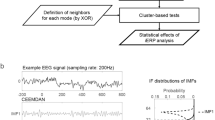Abstract
Entropy, a measure of the regularity of a time series, has long been used to quantify the complexity of brain dynamics. Given the multiple spatiotemporal scales inherent in the brain, traditional entropy analysis based on a single scale is not adequate to accurately describe the underlying nonlinear dynamics. Intrinsic mode entropy (IMEn) is a recent development with appealing properties to estimate entropy over multiple time scales. It is a multiscale entropy measure that computes sample entropy (SampEn) over different scales of intrinsic mode functions extracted by empirical mode decomposition (EMD) method. However, it suffers from both mode-misalignment and mode-mixing problems when applied to multivariate time series data. In this paper, we address these two problems by employing the recently introduced multivariate empirical mode decomposition (MEMD). First, we extend the MEMD to multi-channel multi-trial neural data to ensure the IMEn matched at different scales. Second, for the discriminant analysis of IMEn, we propose to improve the discriminative ability by including variance that has not been used before in entropy analysis. Finally, we apply the proposed approach to the multi-electrode local field potentials (LFPs) simultaneously collected from visual cortical areas of macaque monkeys while performing a generalized flash suppression task. The results have shown that the entropy of LFP is indeed scale-dependent and is closely related to the perceptual conditions. The discriminative results of the perceptual conditions, revealed by support vector machine, show that the accuracy based on IMEn and variance reaches 83.05%, higher than that only by IMEn (76.27%). These results suggest that our approach is sensitive to capture the complex dynamics of neural data.






Similar content being viewed by others
References
Amoud H, Snoussi H, Hewson D et al (2007) Intrinsic mode entropy for nonlinear discriminant analysis. IEEE Signal Proc Let 14(5):297–300
Cortes C, Vapnik VN (1995) Support-vector networks. Mach Learn 20:273–297
Costa M, Goldberger AL, Peng C (2002) Multiscale entropy analysis of complex physiologic time series. Phys Rev Lett 89(6):068102
Eckmann JP, Ruelle D (1985) Ergodic theory of chaos and strange attractors. Rev Mod Phys 57:617–656
Grassberger P, Procaccia I (1983) Estimation of the Kolmogorov entropy from a chaotic signal. Phys Rev A 28:2591–2593
Huang NE, Shen Z, Long SR et al (1998) The empirical mode decomposition and the Hilbert spectrum for nonlinear and non-stationary time series analysis. Proc R Soc Lond 454A:903–993
Kosmidou VE, Hadjileontiadis LJ (2009) Sign language recognition using intrinsic-mod sample entropy on sEMG and accelerometer data. IEEE Trans Biomed Eng 56(12):2879–2890
Lake DE, Richman JS, Griffin MP et al (2002) Sample entropy analysis of neonatal heart rate variability. Am J Physiol 283(3):R789–R797
Peng CK, Costa M, Goldberger AL (2009) Adaptive data analysis of complex fluctuations in physiologic time series. Adv Adapt Data Anal 1(1):61–70
Pincus SM (1991) Approximate entropy as a measure of system complexity. Proc Natl Acad Sci USA 88:2297–2301
Rehman N, Mandic DP (2010) Multivariate Empirical Mode Decomposition. Proc R Soc Lond 466A:1291–1302
Richman JS, Moorman JR (2000) Physiological time-series analysis using approximate entropy and sample entropy. Am J Physiol Heart Circ Physiol 278:2039–2049
Richman JS, Lake DE, Moorman JR (2004) Sample entropy. Method Enzymol 384:172–184
Stam CJ (2006) Nonlinear brain dynamics. Nova Science, New York
Wilke M, Logothetis NK, Leopold DA (2003) Generalized flash suppression of salient visual target. Neuron 39(6):1043–1052
Wilke M, Logothetis NK, Leopold DA (2006) Local field potential reflects perceptual suppression in monkey visual cortex. Proc Natl Acad Sci USA 103(46):17507–17512
Wu Z, Huang NE (2009) Ensemble empirical mode decomposition: a noise-assisted data analysis method. Adv Adapt Data Anal 1(1):1–41
Acknowledgments
This work is partially supported by NIH. We thank Dr Melanie Wilke for proving the data, which were collected at the laboratory of Dr Nikos Logothetis at Max Planck Institute for Biological Cybernetics in Germany.
Author information
Authors and Affiliations
Corresponding author
Rights and permissions
About this article
Cite this article
Hu, M., Liang, H. Intrinsic mode entropy based on multivariate empirical mode decomposition and its application to neural data analysis. Cogn Neurodyn 5, 277–284 (2011). https://doi.org/10.1007/s11571-011-9159-8
Received:
Revised:
Accepted:
Published:
Issue Date:
DOI: https://doi.org/10.1007/s11571-011-9159-8




